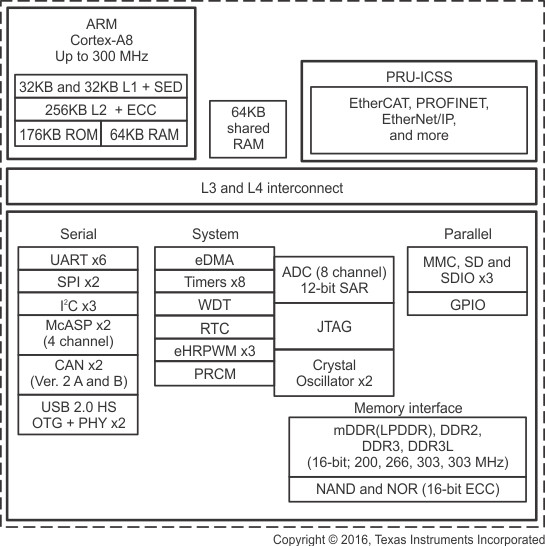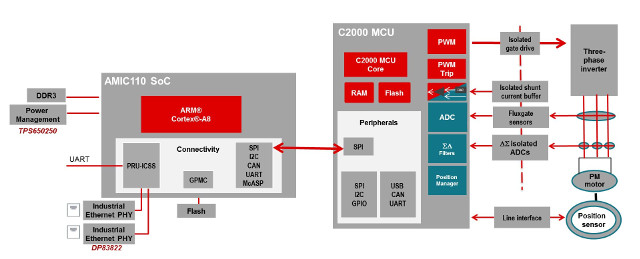Texas Instruments Sitara AM335x SoCs integrate an ARM Cortex A8 processor @ up to 1GHz with a PRU-ICSS for industrial communication, but also include a display controller, an optional PowerVR GPU, and a rich-set of peripherals making it useful for a wide range of applications. The company has now launched AMIC110 Sitara processor with a Cortex A8 core @ 300 MHz, and a PRU-ICSS specifically designed for industrial Ethernet, and fieldbus communication.
 Texas Instruments AMIC110 Sitara processor key features and specifications:
Texas Instruments AMIC110 Sitara processor key features and specifications:
- CPU – ARM Cortex-A8 processor @ up to 300 MHz with NEON, 32+32KB I/D cache, 256KB L2 cache, 176KB boot ROM, 64KB RAM
- External Memory Interfaces (EMIF) – mDDR(LPDDR), DDR2, DDR3, DDR3L Controller up to 1GB
- General-Purpose Memory Controller (GPMC) – 8-bit & 16-bit Asynchronous Memory Interface with up to Seven Chip Selects (NAND, NOR, Muxed-NOR, SRAM)
- 2x programmable Real-Time Unit Subsystem and Industrial Communication Subsystem (PRU-ICSS) supporting EtherCAT, PROFIBUS, PROFINET, EtherNet/IP, and more (10 communication standards in total)
- Misc – Power, Reset, and Clock Management (PRCM) Module; Real-Time Clock (RTC)
- Peripherals
- Up to 2x USB 2.0 OTG Ports
- Up to 2x Controller-Area Network (CAN) Ports v 2 Part A & B
- Up to 2x Multichannel Audio Serial Ports (McASPs)
- Up to 6x UARTs, up to x3 I2C Master and Slave Interfaces
- Up to 2x Master and Slave McSPI Serial Interfaces
- Up to 3x MMC, SD, SDIO Ports
- Up to 4x Banks of General-Purpose I/O (GPIO) Pins with 32 GPIO pins per bank
Up to 3x External DMA Event Inputs that can Also be Used as Interrupt Inputs - 8x 32-Bit General-Purpose Timers
- Watchdog Timer
- 12-Bit Successive Approximation Register (SAR) ADC
- DMA controller
- Device Identification with Electrical Fuse Farm (FuseFarm)
- Debug Interface Support – JTAG and cJTAG for ARM, PRU-ICSS Debug, supports Device Boundary Scan; supports IEEE 1500
- Security – Secure Boot
- Package – 324-Pin S-PBGA-N324 Package (ZCZ Suffix), 0.80-mm Ball Pitch
AMIC110 supports high-level operating systems (HLOS) with Linux and TI-RTOS available free of charge from TI, but other RTOS are supported by partners. While AMIC110 microprocessor can work in standalone mode, it may be used in conjunction with TI C2000 MCUs over SPI for “connected drives” (e.g. motors) as shown in the diagram below.

In order to get started and/or evaluate the new processor, Texas Instruments can also provide AMIC110 ICE (Industrial Communication Engine) evaluation board with the following features:
- SoC – AMIC110 SoC featuring Sitara ARM Cortex-A8 and PRU-ICSS
- System Memory – 512 MByte DDR3
- Storage – 8 MByte SPI flash
- Connectivity – 2x 10/100M industrial Ethernet connectors with external magnetics
- Communication with optional host processor – 3.3V SPI interface to any host processor such as TI C2000
- Debugging – 20-pin JTAG header to support all types of external emulator
- Power Supply – 5-V input supply, single chip power management IC TPS650250 to power entire board and dual DP83822 PHYs
- Certifications – RoHS and REACH compliant design; EMC-compliant, industrial temp dual port EtherCAT slave with SPI interface

Fully documentation with user guides, hardware design files (schematics, PCB layout, Gerber files..), development tools. and software can be downloaded from Technical Documents section of the board’s page.
TI AMIC110 Sitara processor SoC sellers for $6.75 per unit for 1K order, and the development board can be purchase for $195. Visit Texas Instruments AMIC110 product page for further details.
Via LinuxGizmos

Jean-Luc started CNX Software in 2010 as a part-time endeavor, before quitting his job as a software engineering manager, and starting to write daily news, and reviews full time later in 2011.
Support CNX Software! Donate via cryptocurrencies, become a Patron on Patreon, or purchase goods on Amazon or Aliexpress




